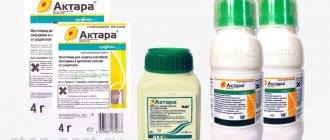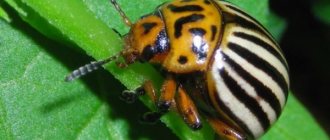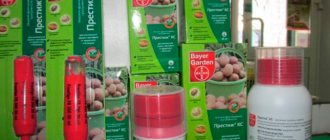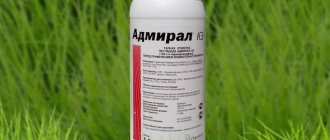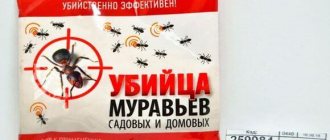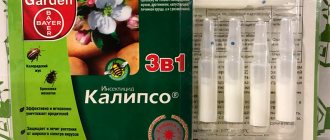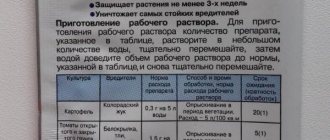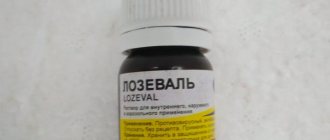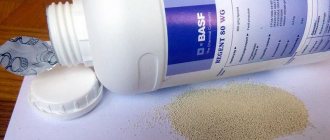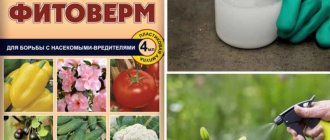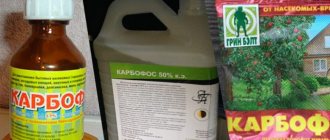Aktara is an insecticide used to quickly get rid of harmful insects (gnawing, mining, sucking pests, as well as bees) that destroy crops, fruits, vegetables, and flowers. The drug has a wide spectrum of action and can be applied to the soil or used as a sprayer.
Aktara drug in various types of packaging.
Purpose of the drug
Aktara is intended for use as an insecticide from the neonicotinoid group. It is effective in getting rid of thrips, scale insects, whiteflies, scale insects, false scale insects, the Colorado potato beetle on potatoes, as well as aphids that live on berries and flower crops. The product has a low effectiveness against whiteflies, but has virtually no effect on arachnid pests.
Suitable for house plants. Does not affect resting puparia larvae, pupae, insect eggs, adults (non-feeding adults).
Composition and release form
Inside the drug there is the substance thiamethoxam (an artificially created derivative of regular nicotine) in different concentrations (240 g/kg or 240 g/l) with ballast.
Release form: in the form of one percent granules or suspension (concentration 25-35%).
| Packaging format: | 0.25 kg. (10×0.25 kg), bag 0.004 kg. (15×0.004 kg. / 10x15x0.004 kg.) |
| Registrar name: | Limited Liability Company "Syngenta" |
Operating principle
Aktara is essentially a paralytic poison. After treating the plant with this product for twenty hours, it penetrates into the leaf tissue (translaminar method of penetration into the plant). When the substance enters the insect’s body through eaten leaves (the predominant route of entry), it affects the nicotinic-acetyl-choline receptors of the postsynapses of the pest’s nervous system.
After this, for a period of time from a quarter of an hour to an hour, the insect stops feeding, and after 2-24 hours it dies. Due to the selective blocking of receptors, the drug does not cause cross-activity with other insecticidal drugs (organophosphorus compounds FOS, pyrethroids, carbomates, other types of neonicotinoids).
However, Aktara is addictive to itself, which is why it needs to be alternated with other types of chemical drugs.
Signs of aphid damage to roses
The solitary aphid is a small insect that has a body length of only 4 mm; it drinks plant juice through its proboscis, but causes minor harm, but this is until the female begins to give birth.
Once a colony of these insects has formed, it becomes very difficult to get rid of them. To protect your roses, you need to constantly inspect their inner leaf surfaces for the presence of aphid larvae, and as soon as they are discovered, treat the entire bush for prevention. You may also be interested in information on how to treat peonies against aphids and ants.
In the video - aphids on roses:
The main signs of aphid infestation of rose bushes are:
- Deformed buds and drooping shoot tips.
- Rolled leaves, at the initial stage they are simply covered in red.
- The plant and its flowers are covered with a sticky coating, on which other insects often sit. Copper dew, as it is called, is loved by ants. If numerous colonies of ants are observed near roses, then this is a sure sign that there are aphids on the bush.
- Falling buds for no apparent reason, yellowed leaves.
Eliminating the culprit of all this is not difficult if you purchase an effective chemical agent. To help you decide on your choice, we list below the most common ones. But this article will help you understand how to use ammonia against aphids on roses, and how to carry out health work.
Safety rules and toxicity
According to the hazard class, the drug Aktara belongs to moderately dangerous (class 3), and at a concentration of 0.02%, that is, about two grams of the active substance for every liter of liquid, it goes into the second. Considering this fact, when working with this substance it is necessary to use all personal protective equipment, namely:
- protective glasses;
- petal respirator;
- headdress;
- special clothes and shoes.
By the way! The hazard class of a chemical varies for different insects. So, for a bee it is the first, and for aquatic and earthen insects it is the fourth.
While processing plants, you should not smoke, eat or drink. After the maximum permissible operating time, which is 2 hours, it is necessary to stop processing plants and trees, wash your hands with soap, and take a shower. It is also necessary to wash plastic protective equipment and wash work clothes.
Under no circumstances should the water used to wash protective devices and containers, as well as the remaining solution, be poured onto the ground, especially in places where drinking water is collected, near water bodies. To properly dispose of a liquid containing Aktara, you need to add a solution of baking soda to it, then after waiting five to ten minutes, pour it down the drain. Chemical packaging must be incinerated or disposed of.
Since bees can be poisoned by not fully absorbed Aktara poison, which enters their body through the usual contact method, the safety zone separating bees and plants treated with the drug should be 4-5 km, no less. Moreover, after treatment with Aktara, four to five days should pass before the bees are released.
Analogues of the insecticide Aktara
The product is indispensable for combating the “army” of gnawing, sucking and other types of harmful insects. But Aktara, like most drugs, has analogues. The following have proven themselves to be excellent: “ALOTAR”, “FIGHTER”, “TIARA”, “NOMINAL”, “EUPHORIA”. The insecticidal properties of these substances have a similar effect when used. They also contain the component Thiamethoxam.
"Aktara" is a high, fast-acting drug. Don't forget about personal protection measures. If you carry out competent treatment measures, you can forget about pests for a long time, preserve and increase your harvest.
Use for various crops
After treating the bush with Aktara, all its parts are saturated with the substance for two to three hours; for a tree, this period is about two days, a maximum of three days. The preferred way of applying the substance is to water the plant with an aqueous solution at the root. Impregnation in this way causes Aktara to remain in its tissues for two months (60 days). In this case, such spraying should only be done by pouring the required amount of solution under the root of the plant.
Spraying is slightly less effective than other methods, but the duration of the effect is from two to four weeks, although the onset of impact is delayed for a certain period. It is for this reason that it is worth using the product exclusively when there is a mass attack of insects.
After proper processing, the bloodsuckers immediately throw away their stilettos, straighten their antennae and freeze. Despite the fact that the pulled out piercing organs make small cuts on the leaves, yield losses are insignificant or completely absent, since the damage heals very quickly without a trace or harm.
The product is not used for green plants (onions, cabbage, parsley and the like).
Houseplants
A 1.2 gram ampoule of the product is diluted in 6 liters of water (enough for 100-150 small plants); after treatment, the room is kept closed for 6 hours after spraying or 2 hours after watering.
Houseplants and the drug Aktara.
When processing in a room, a human operator should remain in a room with the door completely closed only after using personal protective equipment.
You can read in detail about using the product with indoor plants in our specialized material here.
Vegetables
For potatoes, the solution is prepared as follows: 4 grams are mixed with four buckets of water. This means that one sachet weighing 1.4 grams needs to be dissolved with one and a half buckets of liquid, and an ampoule of 1.2 grams is used for two buckets. For every hundred square meters of land, half a bucket of ready-made solution is required.
Emergency use against aphids, Colorado potato beetles and apple growers:
- cabbage (2 times every 14 days, 10 ml bag per 1 bucket per 2 acres);
- eggplants, tomatoes, peppers (same as cabbage, 1-2 sprays);
Spraying tomatoes.
Ground and greenhouse vegetables such as cucumbers and tomatoes are treated with a solution prepared as for potato tubers. The consumption should be about two buckets per one hundred square meters of garden, if the plants are up to one meter in length, 4 buckets per hundred square meters - if the height is more than one meter. Spot watering involves spending 50 ml. on under each bush.
Fruit trees and shrubs
Currants are treated with one ampoule of Aktara, dissolved in 6 liters of water. In this case, you need to pour 100 ml. for each bush, if it is 1 meter high, and 150 ml. for a one and a half meter currant bush.
Treatment of currant bush with Aktara.
The first time the treatment is carried out after harvesting, and the second time after the formation of foliage, but no later than one week before flowering.
You can learn more about the effects of the product on trees in this material.
Consumption rate
Aktara solution is prepared in 2 stages. First, the drug is dissolved in 1 liter of water. This mixture is called the mother liquor. Then the garden sprayer is filled 1/3 with water, the dissolved insecticide is poured in and liquid is added to the desired volume. An example of preparing a working solution for fruit trees:
- 1.4 g of the drug is dissolved in a liter of liquid.
- The garden sprayer is filled with 3 liters of water.
- Pour in the mixture.
- Add 6 liters of water.
Insecticide consumption for young fruit trees is 2 liters; for spraying an adult crop you will need 5 liters of working solution. In industrial gardening, spraying is carried out by machine and the following dosage is observed: 1.4 g of pesticide is first diluted with 3 liters of water, and then each liter of product is brought to 10 liters of working solution by adding liquid.
Preparation of a solution with actara against pests
Actions in cases of poisoning
Characteristic signs of an undesirable reaction when using Actara is the formation of ptosis, that is, swelling of tissues with their simultaneous redness, as well as involuntary adhesion. Common symptoms also include nausea and weakness. It is necessary to immediately stop working with the substance, go out into fresh air or move the person affected by poisoning there.
To eliminate the consequences of incipient poisoning, you will need to induce vomiting by first drinking about three to four glasses of water. This rule under no circumstances applies to an unconscious person.
When help is provided, you need to consult a doctor and report all signs of poisoning found.
Storage conditions and shelf life
Akara should be stored in a securely closed place at a temperature from – 10 0C to + 35 0C. Proximity to food products, animal feed, and other agrochemicals is prohibited. However, children and animals should not have access to this substance.
The effectiveness and safety of Aktara is guaranteed by the manufacturer only if the drug is used in strict accordance with the instructions for preparation, use, and disposal.
If the package has already been opened, dry Aktara will be good for another four years, and liquid Aktara for a maximum of one year. It is advisable to use any opened substance during the current season.
Working solutions prepared for use cannot be stored.
Reviews
The effectiveness and practicality of the drug is fully confirmed by the instructions for use. Aktara also collects positive reviews from almost all gardeners who have used the product on their plots. The disadvantages include the gram packaging, since there are a lot of granules for processing house plants or small gardens. Also, the drug does not affect the larvae, so re-treatment may be required after a few days.
Otherwise, the product has proven itself well among gardeners and among home plant lovers. The drug really copes with pests within 20-30 minutes after use. Some still note that its effect ends earlier than the stated period or after rain, but repeated treatments always help save the entire crop.
